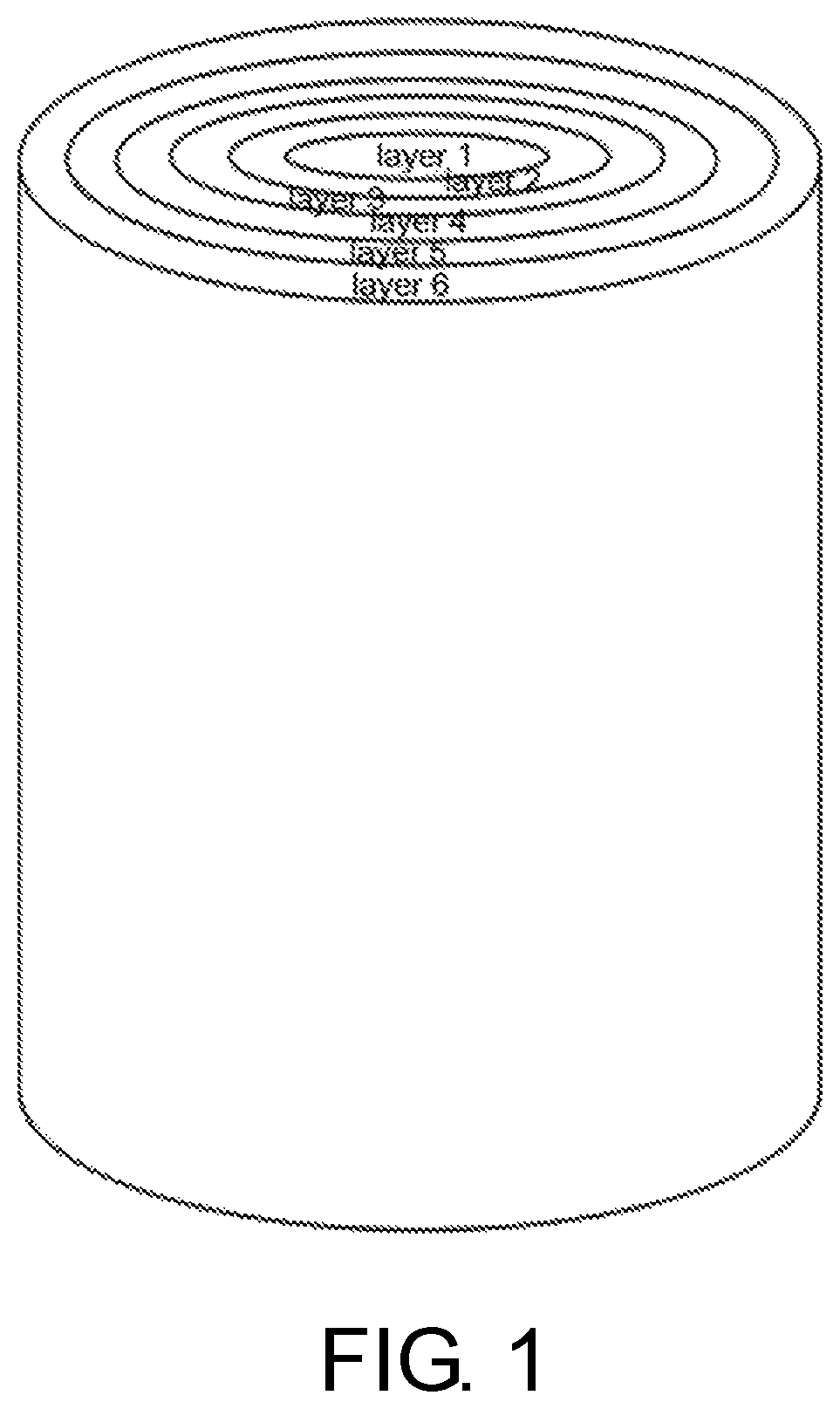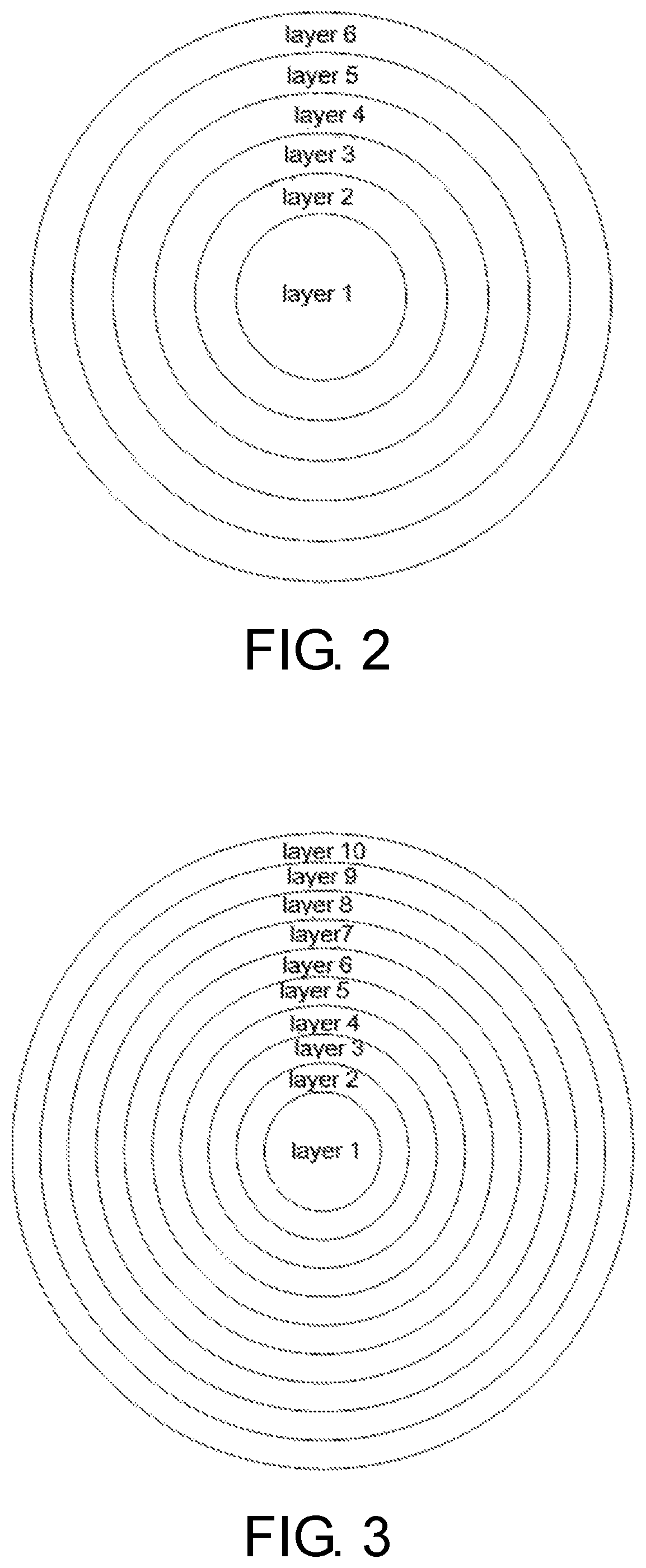Ultralight artificial medium multilayer cylindrical lens
a technology of artificial medium and cylindrical lens, applied in the field of nanotechnology, can solve the problems of small number of applications, difficult to enter the civilian sector, difficult to apply on a large scale, etc., and achieve the effects of accurate measurement, simple and convenient fabrication techniques, and full dominance of field strength
- Summary
- Abstract
- Description
- Claims
- Application Information
AI Technical Summary
Benefits of technology
Problems solved by technology
Method used
Image
Examples
example 1
[0057]Referring to FIG. 1 and FIG. 2, in one embodiment of the present invention, a six-layer artificial medium cylindrical lens having a height of 30 cm and a diameter of 36 cm is provided. Table 1 shows specific parameters of each layer of the lens. The resulting lens has a total apparent density of only 0.092 g / cm3, ultra-low density and ultra-light weight.
[0058]
TABLE 1layerlayerlayerlayerlayerlayerlayer123456Design1.851.61.451.31.151.08dielectricconstant valueFinal dielectric1.85 + / −1.6 + / −1.45 + / −1.3 + / −1.15 + / −1.08 + / −constant value0.050.050.060.070.030.03Inside diameter—95.5156.4208.6256.9311.4(mm)Outer diameter95.4156.3208.4256.8311.2360.2(mm)
[0059]When the cylindrical lens is applied to a multi-beam antenna, due to the special action of its columnar structure on the elevation plane, a complicated electro-optic down-tilt mechanism can be omitted compared to a conventional spherical or hemispherical lens. Such as a 6-layer cylindrical lens provided by the present invention, t...
example 2
[0060]Referring to FIG. 3, in another embodiment of the present invention, a 10-layer artificial medium cylindrical lens having a height of 50 cm and a diameter of 65 cm is provided, table 2 shows specific parameters of each layer of the lens, and is finally made, the total apparent density of the lens is only 0.086 g / cm3, the density is ultra-low, the quality is ultra-light, and the application range is wider.
[0061]
TABLE 2Layerlayerlayerlayerlayerlayerlayerlayerlayerlayerlayer12345678910Design1.951.851.71.581.481.381.281.181.11.05dielectricconstantvalueFinal1.95 + / −1.85 + / −1.7 + / −1.58 + / −1.48 + / −1.38 + / −1.28 + / −1.18 + / −1.1 + / −1.05 + / −dielectric0.030.030.040.030.030.040.030.040.030.02constantvalueInside—175.7236.4293.2345.9396.9447.2496.7548.4600.4diameter(mm)Outer175.6236.3293.2345.8396.9447.1496.7548.4600.3650.1diameter(mm)
[0062]In addition, when the cylindrical lens is used to construct a multi-beam antenna in the antenna system, combined with the antenna element, a 10-beam full-...
PUM
| Property | Measurement | Unit |
|---|---|---|
| dielectric constant | aaaaa | aaaaa |
| apparent density | aaaaa | aaaaa |
| apparent density | aaaaa | aaaaa |
Abstract
Description
Claims
Application Information
 Login to View More
Login to View More - R&D
- Intellectual Property
- Life Sciences
- Materials
- Tech Scout
- Unparalleled Data Quality
- Higher Quality Content
- 60% Fewer Hallucinations
Browse by: Latest US Patents, China's latest patents, Technical Efficacy Thesaurus, Application Domain, Technology Topic, Popular Technical Reports.
© 2025 PatSnap. All rights reserved.Legal|Privacy policy|Modern Slavery Act Transparency Statement|Sitemap|About US| Contact US: help@patsnap.com


